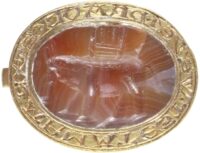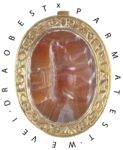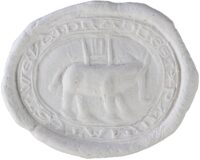 An extremely rare medieval gold seal engraved with the image of an elephant carrying a castle on its back has been discovered in Norfolk. It was discovered in June 2020 by a metal detectorist near King’s Lynn. The seal dates to between 1250 and 1350 and is only the third gold seal ever recorded by the Portable Antiquities Scheme, and the only one to star an elephant.
An extremely rare medieval gold seal engraved with the image of an elephant carrying a castle on its back has been discovered in Norfolk. It was discovered in June 2020 by a metal detectorist near King’s Lynn. The seal dates to between 1250 and 1350 and is only the third gold seal ever recorded by the Portable Antiquities Scheme, and the only one to star an elephant.
“Few people in medieval England would have seen a live elephant,” said Beverley Nenk, curator of later medieval collections at the British Museum.
“The image may have been based on reports of these fabulous and exotic creatures from travellers or pilgrims returning from the East or from the Crusades, or from descriptions and images in bestiaries and other manuscripts.”
There was a live elephant in the royal menagerie at the Tower of London between 1255 and 1257 – a gift from King Louis IX of France to King Henry III.
The seal is just over an inch long, a gold oval set with an oval stone intaglio stone engraved with an elephant in profile walking towards the right, its trunk curled forward at the tip. On his back is a castle (an adaptation of the howdah, the canopied seat carried by Asian war elephants). The stone is probably a carnelian, although there is some slight banding like you see in agate. It is backed and rimmed in gold and there is a gold loop soldered to the reverse.
 There is no name on the seal (the other gold seals are also anonymous), but there is an inscription. It reads: PARMAT EST ‧ WEVEI ‧ DRA OBEST, a bit of an obscure saying which is being interpreted as meaning “armed with a shield, the outlaw dragon is harmful.” The connection between the castled elephant and the inscription is equally obscure. It could be a reference to the idea, commonly expressed in medieval bestiaries, that dragons were elephants’ only natural enemies.
There is no name on the seal (the other gold seals are also anonymous), but there is an inscription. It reads: PARMAT EST ‧ WEVEI ‧ DRA OBEST, a bit of an obscure saying which is being interpreted as meaning “armed with a shield, the outlaw dragon is harmful.” The connection between the castled elephant and the inscription is equally obscure. It could be a reference to the idea, commonly expressed in medieval bestiaries, that dragons were elephants’ only natural enemies.
In medieval heraldry, elephants symbolized power, wisdom and courage. Because they were associated with Eastern rulers, elephants on a coat of arms could refer to a victory or success in the East. The castle on the back is associated with royalty and combat. Christian iconography used the elephant as a symbol of Christ’s redemption of fallen humanity.
 The date range is suggested by the lettering, which is 13th century in style, and by comparison to other seal matrices set with gemstones that were created in the early 14th century. It is not clear if the intaglio itself is medieval. It could just as easily be ancient, as ancient engraved gemstones were reused in seals and jewelry in the Middle Ages.
The date range is suggested by the lettering, which is 13th century in style, and by comparison to other seal matrices set with gemstones that were created in the early 14th century. It is not clear if the intaglio itself is medieval. It could just as easily be ancient, as ancient engraved gemstones were reused in seals and jewelry in the Middle Ages.
The seal’s status under the Treasure Act 1996 will be determined at a coroner’s inquest at the end of the month. As it is made of more than 10% precious metal and is more than 300 years old, the will certainly be declared official Treasure, after which a British Museum committee of experts will assess its market value. Local museums will be given first crack at the chance to pay the fee (split by the finder and landowner). The Norwich Castle Museum has already expressed a desire to acquire it when it becomes available.
—–
“parmat(us) est ‧ wevei ‧ dra[(g/c)o](ne?) obest”?!?
—–
‘parmatus’ = bearing the ‘parma’/ with light shields, light-armed. From ‘parma’, a small round shield, light shield, target (for cavalry or light infantry). ‘Dra(g/c)[o]’ speaks for itself, while ‘obest’ = something is harming or opposes. On the other hand, ‘wevei’ is hard to come by (a sort of medieval “covfefe”?!? 😮 ).
“Shielded is he, who opposes tha dragon”?!? –Where did the “outlaw” come into play? :confused:
However,…
…already ‘Abul-Abbas’ the elephant had been sent as a gift by (Abu al-Abbas al-Maʾmūn ibn) Hārūn al-Rashīd and brought from Baghdad by a Frankish Jew named Isaac. Along with two other emissaries, Lantfrid and Sigimund, Isaac had been received by the caliph in 798, according to the ‘Annales regni Francorum’:
In 801AD, Isaac as the only surviving member arrived at Pisa, i.e. with the elephant and two Abbasid emissaries. They were met by Charlemagne. One emissary was sent by the caliph himself, the other one by Abraham (Ibrahim ibn al-Aghlab), governor of Africa. The emperor commissioned a fleet of ships to carry the elephant and other goods back to Aachen.
——-
[Anno 801] “…Ibi nuntiatur ei, legatos Aaron Amir al Mumminin regis Persarum portum Pisas intrasse. Quibus obviam mittens inter Vercellis et Eporeiam eos sibi fecit praesentari; unus enim ex eis erat Persa de Oriente, legatus regis Persarum, – nam duo fuerant – alter Sarracenus de Africa, legatus amirati Abraham, qui in confinio Africae in Fossato praesidebat. Qui Isaac Iudeum, quem imperator ante quadriennium ad regem Persarum cum Lantfrido et Sigimundo miserat, […] qua elefans et ea, quae cum eo deferebantur, subveherentur.”
——-
In 810, the emperor left his palace in Aachen and mounted a campaign intending to engage with King Godofrid of Denmark and his fleet that had invaded and plundered Friesland. They crossed the Rhine at a place called “Lippeham” (Wesel/ North Rhine-Westphalia, obviously), where unfortunately poor ‘Abul-Abbas’ suddenly died:
——-
[810] “…deinde transmisso Rheno flumine in loco, qui Lippeham vocatur, copias, quae nondum convenerant, statuit operiri; ubi dum aliquot dies moraretur, elefans ille, quem ei Aaron rex Sarracenorum miserat, subita morte periit”
——-
:hattip:
——
“parmat(us) est ‧ qui ‧ dra[(g/c)o](ne) obest” –si vis pacem para bellum.
——
Yes, my own picture of “Law-abiding Dragons in medieval England” is still a rather fuzzy one, but I live on the Continent.
The draco, however, was a military standard of the Roman cavalry. Carried by the draconarius, the draco was the standard of the cohort, as the eagle (‘aquila’) was that of the legion.
Here, the ‘dragon’ is not necessary the antichrist himself: Derived from those ‘Dracones’ as military standard, the coat of arms of Wessex, Wales and other local powers might have been no coincidence.
An elephant and castle can be found in the coat of arms of Coventry (Holy Trinity Church, center below the trinity):
upload.wikimedia.org/wikipedia/commons/9/9e/Holy_Trinity_Church,_Coventry_-_stained_glass_window.jpg
Like any other cat (occasionally killing and eating –often not eating– a lizzard, who are rather slow in the morning sun), most European medieval rulers had to be moving around in and around their territory. They did not rule from a capital, but had to maintain personal contact with their vassals on the ground, i.e. “itinerant kingship”.
:hattip:
Before I shut up for today, here a possible a clue to the “WEVEI”
I am no native speaker and, therefore, I personally need to look those things up:
en.wikipedia.org/wiki/Wyvern –Dative “wevei”, I suppose 😉
———
“The wyvern in its various forms is important to heraldry, frequently appearing as a mascot of schools and athletic teams (chiefly in the United States, United Kingdom, and Canada). It is a popular creature in European literature, video games, and modern fantasy. The wyvern in heraldry and folklore is rarely fire-breathing, unlike the four-legged dragon.
According to the Oxford English Dictionary, it is an alteration of Middle English wyver (attested thirteenth century), from Anglo-French wivre, meaning “viper”, “adder”, or “asp”. Conversely, medievalist William Sayers proposes a more complex origin for the term. He notes that the Anglo-French guivre and its Middle English derivative ceased to retain the original sense of “venomous snake” after the Latin term was re-introduced into medieval Latin, freeing them up to take an alternate meaning…”
———
A (red) ‘Draco’ as military standard (of which I am unsure if it would count as “Wyvern”) is depicted on the Bayeux Tapestry:
upload.wikimedia.org/wikipedia/commons/5/54/Bayeux_Tapestry_3.jpg
There was an inn south of London called The Elephant and Castle. There is a tube (subway) station there now called the by the same name. See Wikipedia article on same.